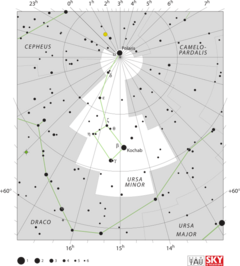Astronomy:Eta Ursae Minoris
| Observation data Equinox J2000.0]] (ICRS) | |
|---|---|
| Constellation | Ursa Minor |
| Right ascension | 16h 17m 30.27025s[1] |
| Declination | +75° 45′ 19.2351″[1] |
| Apparent magnitude (V) | +4.95[2] |
| Characteristics | |
| Evolutionary stage | main sequence[3] |
| Spectral type | F5 V[4] |
| U−B color index | +0.02[2] |
| B−V color index | +0.35[2] |
| Astrometry | |
| Radial velocity (Rv) | −11.0±0.9[5] km/s |
| Proper motion (μ) | RA: −77.647[1] mas/yr Dec.: +245.726[1] mas/yr |
| Parallax (π) | 33.4190 ± 0.1103[1] mas |
| Distance | 97.6 ± 0.3 ly (29.92 ± 0.10 pc) |
| Absolute magnitude (MV) | +2.61[6] |
| Details | |
| Mass | 1.35[7] M☉ |
| Radius | 2.0[1] R☉ |
| Luminosity | 7.7[1] L☉ |
| Surface gravity (log g) | 4.15±0.14[7] cgs |
| Temperature | 6,858±233[7] K |
| Metallicity [Fe/H] | −0.02[8] dex |
| Rotational velocity (v sin i) | 84.8[3] km/s |
| Age | 1.061[7] Gyr |
| Other designations | |
| Database references | |
| SIMBAD | data |
Eta Ursae Minoris (Latinized from η Ursae Minoris) is a yellow-white hued star in the northern circumpolar constellation of Ursa Minor.
This is an F-type main-sequence star of stellar classification F5 V with an apparent magnitude of +4.95, making it faintly visible to the naked eye.[10] Based upon an annual parallax shift of 33.4 mas as seen from the Earth, it is located 98 light years from the Sun. The star is moving closer to the Sun with a radial velocity of −11 km/s,[5] and is traversing the sky with a relatively high proper motion of 0.271 arc seconds per year.[11]
Eta Ursae Minoris is about one billion years old and has an estimated 1.35 times the mass of the Sun.[7] It has a high rate of spin with a projected rotational velocity of 84.8 km/s.[3] These coordinates mark a source of X-ray emission with a luminosity of 11.5×1028 erg s−1.[6] Eta Ursae Minoris may form a wide binary system with a magnitude 15.3 companion star, located at an angular separation of 228.5 arc seconds.[4]
In some Arabic star charts it is labeled انور الفرقدين ʼanwar al-farqadayn, "the brighter of the two calves", and paired with ζ Ursae Minoris as اخفي الفرقدين akhfā al-farkadain "the dimmer of the two calves". The names may originally refer to a pair of Ibexes, and are more properly applied to β UMi and γ UMi respectively, the brighter two stars in the rectangle of Ursa Minor.[12]
References
- ↑ 1.0 1.1 1.2 1.3 1.4 1.5 1.6 Vallenari, A. et al. (2022). "Gaia Data Release 3. Summary of the content and survey properties". Astronomy & Astrophysics. doi:10.1051/0004-6361/202243940 Gaia DR3 record for this source at VizieR.
- ↑ 2.0 2.1 2.2 Mermilliod, J.-C. (1986), "Compilation of Eggen's UBV data, transformed to UBV (unpublished)", Catalogue of Eggen's UBV Data, Bibcode: 1986EgUBV........0M. See the SIMBAD Measurements entry for details.
- ↑ 3.0 3.1 3.2 Schröder, C.; Reiners, Ansgar; Schmitt, Jürgen H. M. M. (January 2009), "Ca II HK emission in rapidly rotating stars. Evidence for an onset of the solar-type dynamo", Astronomy and Astrophysics 493 (3): 1099–1107, doi:10.1051/0004-6361:200810377, Bibcode: 2009A&A...493.1099S
- ↑ 4.0 4.1 Eggleton, P. P.; Tokovinin, A. A. (September 2008), "A catalogue of multiplicity among bright stellar systems", Monthly Notices of the Royal Astronomical Society 389 (2): 869–879, doi:10.1111/j.1365-2966.2008.13596.x, Bibcode: 2008MNRAS.389..869E.
- ↑ 5.0 5.1 Gontcharov, G. A. (November 2006), "Pulkovo Compilation of Radial Velocities for 35495 Hipparcos stars in a common system", Astronomy Letters 32 (11): 759–771, doi:10.1134/S1063773706110065, Bibcode: 2006AstL...32..759G.
- ↑ 6.0 6.1 Pizzolato, N. et al. (September 2000), "Evolution of X-ray activity of 1-3 Msun late-type stars in early post-main-sequence phases", Astronomy and Astrophysics 361: 614–628, Bibcode: 2000A&A...361..614P.
- ↑ 7.0 7.1 7.2 7.3 7.4 David, Trevor J.; Hillenbrand, Lynne A. (2015), "The Ages of Early-Type Stars: Strömgren Photometric Methods Calibrated, Validated, Tested, and Applied to Hosts and Prospective Hosts of Directly Imaged Exoplanets", The Astrophysical Journal 804 (2): 146, doi:10.1088/0004-637X/804/2/146, Bibcode: 2015ApJ...804..146D.
- ↑ Casagrande, L. et al. (June 2011), "New constraints on the chemical evolution of the solar neighbourhood and Galactic disc(s). Improved astrophysical parameters for the Geneva-Copenhagen Survey", Astronomy and Astrophysics 530: A138, doi:10.1051/0004-6361/201016276, Bibcode: 2011A&A...530A.138C.
- ↑ "eta UMi". SIMBAD. Centre de données astronomiques de Strasbourg. http://simbad.u-strasbg.fr/simbad/sim-basic?Ident=eta+UMi.
- ↑ Kaler, James B., "Anwar al Farkadain", Stars (University of Illinois), http://stars.astro.illinois.edu/sow/anwar.html, retrieved 2014-06-21.
- ↑ Lépine, Sébastien; Shara, Michael M. (March 2005), "A Catalog of Northern Stars with Annual Proper Motions Larger than (LSPM-NORTH Catalog)", The Astronomical Journal 129 (3): 1483–1522, doi:10.1086/427854, Bibcode: 2005AJ....129.1483L.
- ↑ Allen, Richard Hinckley (1899), Star-names and Their Meanings, G. E. Stechert, pp. 447–460, https://books.google.com/books?id=5xQuAAAAIAAJ&pg=447-460.
 |


